The journalistic landscape is undergoing a revolution thanks to AI, offering unprecedented efficiency and accuracy. Journalists now harness AI’s power to navigate immense data volumes, unveiling hidden trends and valuable insights that might have otherwise gone unnoticed. This article will guide you through an exploration of the 10 best AI tools for journalists in the present day. We will explore how these resources can enhance your work and contribute to your professional development.
How AI Tools Can Elevate Journalists’ Work? ✅
- Automated Writing and Content Generation
AI can help generate news articles, reports, and summaries based on data and information. Journalists can use AI-powered tools to quickly draft initial versions of articles, which they can then edit and refine.
- Data Analysis and Visualization
AI can process and analyze large datasets, extracting insights and trends from complex information. It can also help create data visualizations and infographics to make data-driven stories more accessible to readers.
- Language Translation
AI-powered translation tools can help journalists work with sources and materials in different languages, making it easier to access global news and information.
- Content Curation
AI-driven algorithms can assist in curating and recommending relevant articles and sources for journalists. These algorithms can help journalists discover new stories and stay updated on relevant topics.
- Social Media Monitoring
AI tools can track social media trends and conversations, helping journalists identify breaking news stories, monitor public sentiment, and engage with their audience effectively.
- Speech-to-Text and Transcription
These AI-powered speech recognition and transcription tools can help journalists quickly transcribe interviews, press conferences, and other spoken content, saving time on manual transcription.
- Image and Video Analysis
AI can analyze images and videos to detect objects, faces, emotions, and more. This is particularly useful for investigative journalism and fact-checking.
>> Don’t Miss: 7 Best AI Tools for Real Estate (2024)
10 Best AI Tools for Journalists 🏆
Grammarly
Grammarly is An AI-powered writing assistant that helps journalists improve the quality of their written content by checking for grammar, spelling, and style errors.
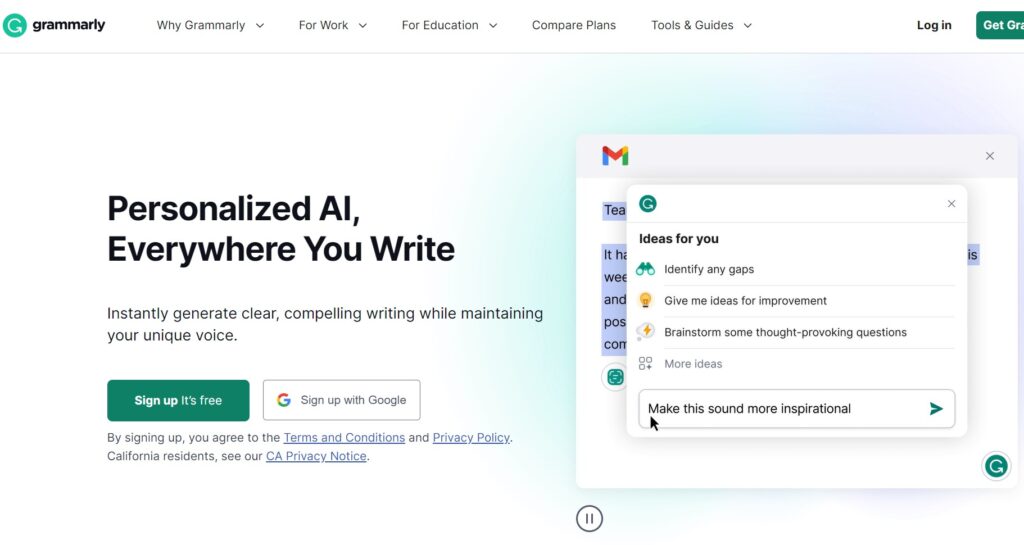
💻Key Features:
- Grammarly scans your text for grammatical errors and spelling mistakes, providing real-time suggestions for corrections.
- Punctuation and Style Checker.
- Vocabulary Enhancement.
- It can provide feedback on the tone of your writing, helping you align it with the intended audience or purpose (e.g., formal, casual, academic).
- Plagiarism Checker.
👍Pros:
- Immediate feedback and suggestions.
- It offers insights into how easy it is to understand your text.
- It provides performance statistics and tracks your writing progress over time.
- Professional writing assistance.
👎Cons:
- Relying solely on Grammarly may hinder users from developing their editing and proofreading skills.
- Occasionally, Grammarly may flag correct usage as an error or miss certain errors.
💰Pricing:
- Free Plan: Free
- Premium Plan: Starting at $10.00 per month
- Business Plan: Starting at $15.00 per member per month
Google Trends
This tool can provide valuable insights into what topics are currently trending on the internet, helping journalists identify popular news stories.

💻Key Features:
- Google Trends presents historical search volume information, enabling users to track the changes in popularity of a specific search term.
- Users can access a graphical representation illustrating the search interest for a specific query across a defined time frame.
- It provides a list of related queries and topics that are often searched alongside the user’s specified query.
- Regional Data.
- Trending Searches. Google Trends highlights the latest trending search queries, giving users an up-to-date view of what is currently popular on the platform.
👍Pros:
- Google Trends offers free and easily accessible data.
- Users can access real-time data.
- The tool allows for the comparison of multiple search terms.
- Users can drill down to specific regions and cities to target local or regional audiences effectively.
- Google Trends can reveal recurring patterns and seasonal trends.
👎Cons:
- Google Trends provides relative data rather than absolute search volume numbers.
- The tool’s historical data is limited, and older trends may not be as easily accessible.
- It does not provide the context behind search trends.
💰Pricing:
Google Trends is a free online tool.
ChatGPT
AI models like ChatGPT can assist journalists in generating content, conducting interviews, and even automating routine tasks like transcribing interviews.
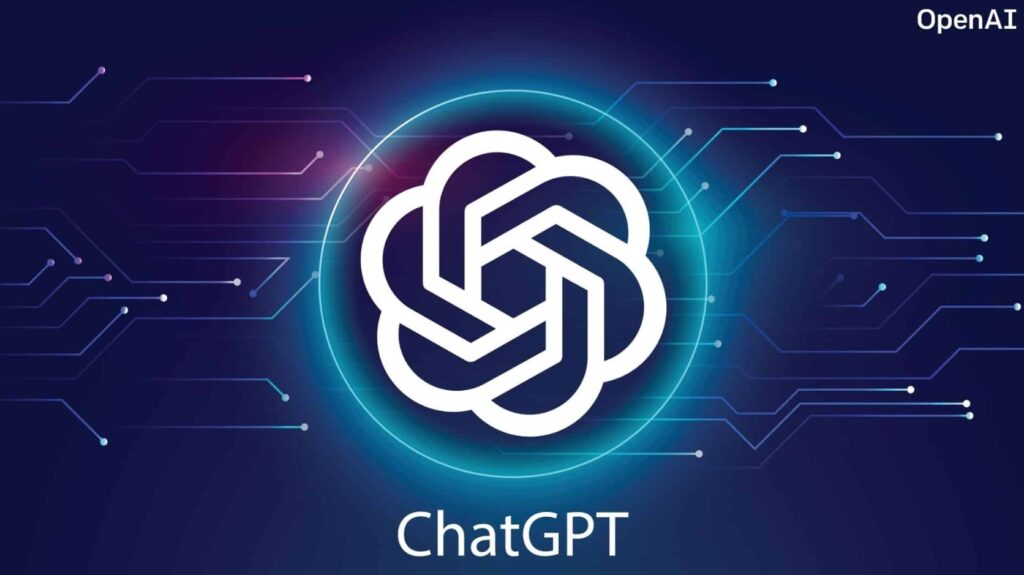
💻Key Features:
- Content Summarization.
- Question Answering.
- Text Completion.
- Language Translation.
- Text Analysis, text classification, and other text-based analysis tasks.
- Content Generation Assistance. ChatGPT can help writers overcome writer’s block and generate creative ideas.
👍Pros:
- It can be applied to various natural language processing tasks, from text generation to conversation.
- It can understand and generate text in a human-like manner.
- ChatGPT is context-aware and can maintain meaningful conversations by considering previous interactions.
- It supports multiple languages.
- It can assist with content creation.
👎Cons:
- The tool lacks true comprehension and may generate responses that are contextually incorrect or nonsensical.
- It can sometimes produce offensive, biased, or inappropriate responses.
💰Pricing:
- ChatGPT-3.5: Free
- GPT-4 model: $20 per month
Zapier
This automation tool can help journalists streamline their workflows by connecting various apps and services, automating repetitive tasks, and saving time.
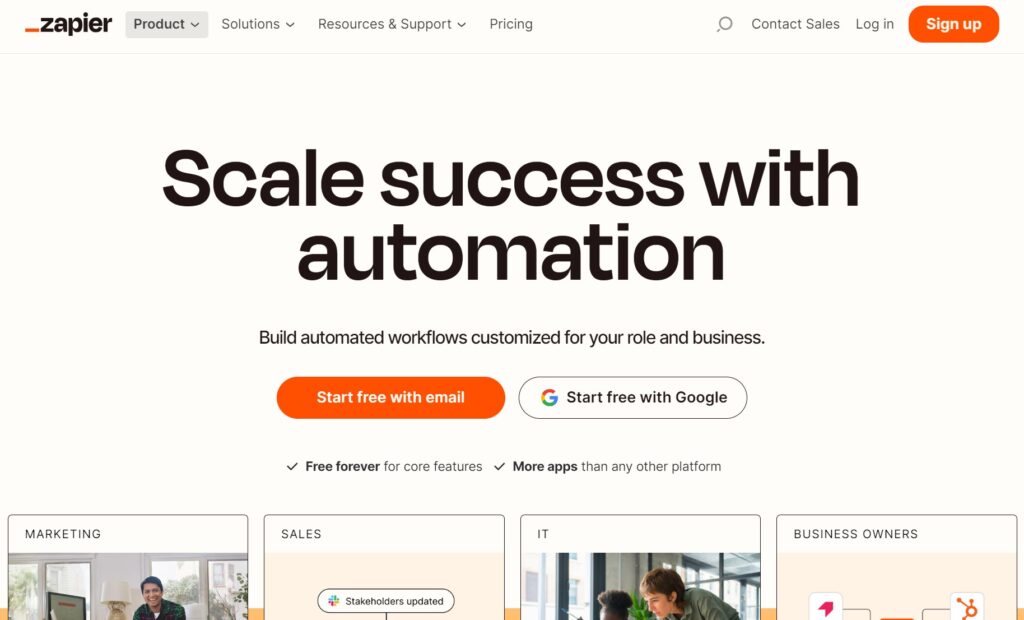
💻Key Features:
- App Integration. Zapier connects to thousands of popular apps.
- Automation (Zaps). Users can set up automated workflows called “Zaps,” which are triggered by specific events or actions in one app and result in actions in another app.
- Zapier supports multi-step workflows.
- Triggers are events or conditions that initiate a Zap, such as receiving an email, form submission, or new data entry in a spreadsheet.
- Actions are tasks or events that Zapier performs automatically based on triggers, like sending emails, creating tasks, or updating records in another app.
- Filtering: Users can set conditions or filters to control when a Zap should run, ensuring that it operates only when specific criteria are met.
👍Pros:
- It streamlines workflows by automating tasks and reducing manual work.
- Zapier allows for complex automation sequences with multiple steps, conditional logic, and custom triggers and actions.
- It enables the integration of apps that might not have built-in connections.
- Users save time by automating repetitive tasks, data transfers, and notifications.
- Zapier can grow with your needs, supporting simple one-step Zaps or more complex, multi-step workflows.
👎Cons:
- There might be a slight delay in the execution of Zaps.
- Zapier relies on the APIs of various third-party apps, and if those APIs change or go offline, it can disrupt automation.
- Running many Zaps continuously may consume system resources and lead to performance issues on low-powered devices.
💰Pricing:
>> Free Plan:
- $0 (free forever).
- Includes 100 tasks per month.
>> Starter Plan:
- $16.84 per month, billed annually.
- Offers 750 tasks per month.
>> Professional Plan:
- $41.28 per month, billed annually.
- Provides 2,000 tasks per month.
>> Team Plan:
- $58.12 per month, billed annually.
- Offers 2,000 tasks per month.
>> Company Plan:
- Contact Zapier Sales for pricing details.
Otter.ai
Useful for transcribing interviews and recording notes during interviews, Otter.ai utilizes AI to transcribe spoken words into text in real time.
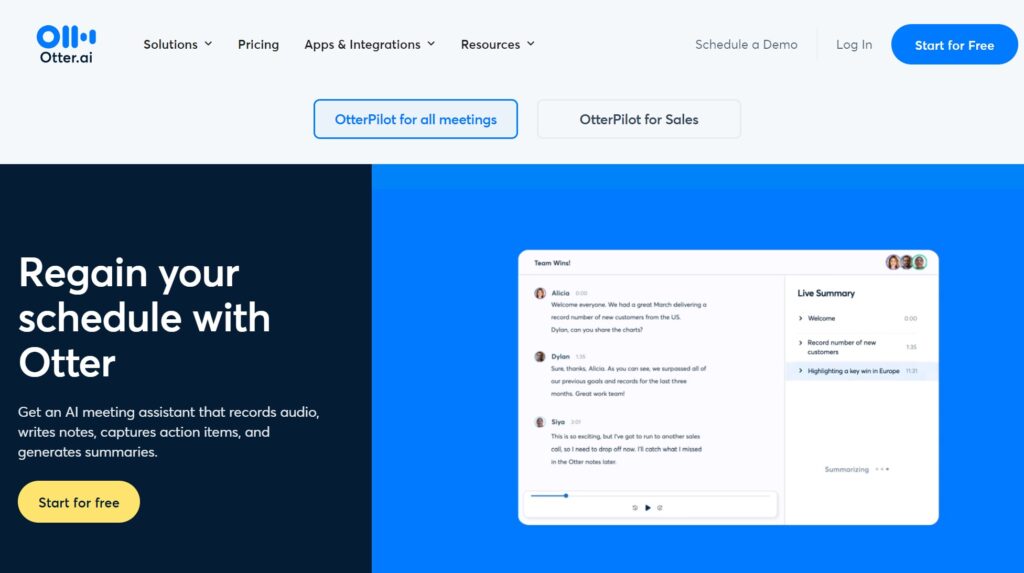
💻Key Features:
- Import Audio Files.
- Sync with Calendar.
- Search and Highlight specific keywords in transcribed content.
- Speaker Identification and can label speakers during conversations or interviews.
- Rich Text Formatting for clear note-taking.
- File Export including plain text, Word documents, and PDFs.
👍Pros:
- Otter.ai uses advanced speech recognition technology.
- It offers real-time transcription.
- Otter.ai can identify different speakers, enhancing transcript organization in multi-speaker scenarios.
- Users can train the system to recognize specific voices.
- Transcriptions are text-based and searchable.
- The availability of mobile apps allows users to transcribe content on the go.
👎Cons:
- Training the system for speaker recognition can be time-consuming.
- Otter.ai may have difficulty accurately transcribing conversations with multiple speakers who frequently talk over each other.
- The quality of the audio source can significantly affect the accuracy of transcription.
💰Pricing:
- Basic Plan: Free.
- PRO Plan: $8.33 per month.
- Business Plan: $20 per user per month.
- Enterprise Plan: Custom pricing based on your specific needs.
Datawrapper
For data visualization, Datawrapper allows journalists to create interactive and engaging charts and graphs to accompany their stories.
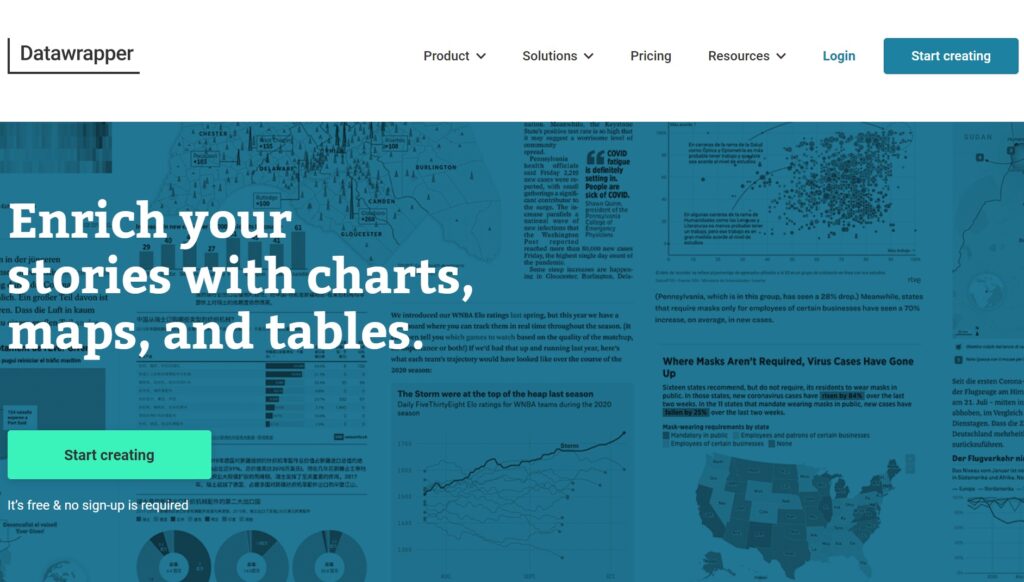
💻Key Features:
- Wide Range of Chart Types, including bar charts, line charts, scatter plots, pie charts, maps, and more.
- Data Cleaning and Formatting.
- Interactive Charts with features like hover-over effects, clickable legends, and tooltips.
- Map Visualization is used to visualize geographical data for data classifications.
- Export of images or interactive iframes.
- Datawrapper provides chart templates and layouts.
- Data Security.
- Version History for tracking changes and accessing previous versions of their visualizations.
👍Pros:
- Customization.
- Charts and visualizations created with Datawrapper are responsive and adapt well to different screen sizes and devices.
- It supports importing data from various sources and integrates with popular data platforms.
- Datawrapper is designed with accessibility in mind, ensuring that charts are usable by a wide range of audiences.
- Users can maintain real-time data in their visualizations.
👎Cons:
- Datawrapper’s data cleaning and transformation capabilities are not as extensive as those of dedicated data analysis tools.
- Performing complex data analysis tasks may require additional software.
💰Pricing:
- Free Plan: Free of charge.
- Custom Plan: Price: $599 per month or $5990 per year (excluding VAT).
- Enterprise Plan: Contact Datawrapper for a quote.
MonkeyLearn
MonkeyLearn is a text analysis tool, which can help journalists extract valuable insights from large amounts of text data, such as social media posts or documents.

💻Key Features:
- Text Classification into predefined categories or labels.
- Users can determine the sentiment of text data, such as positive, negative, or neutral.
- MonkeyLearn can identify entities like names, dates, and organizations in text.
- Keyword Extraction from text.
- Text Extraction such as email addresses, phone numbers, or URLs.
- API Integration.
- Text Summarization.
👍Pros:
- Offers real-time analysis for its users.
- MonkeyLearn supports multiple languages.
- The platform offers data visualization tools to help users gain insights from text data, including word clouds and graphs.
- It supports collaborative work on text analysis projects.
- Users can create custom analysis workflows with multiple steps and conditions.
👎Cons:
- Customizing machine learning models and creating advanced analysis workflows may require some expertise.
- The platform may have limitations on the size of data that can be analyzed or imported.
💰Pricing:
- Starting Price: $299.00 per month
- Free Version: Available
- Free Trial: Available
Rev.com
This is an AI-powered transcription service that can convert audio and video content into written transcripts quickly and accurately.
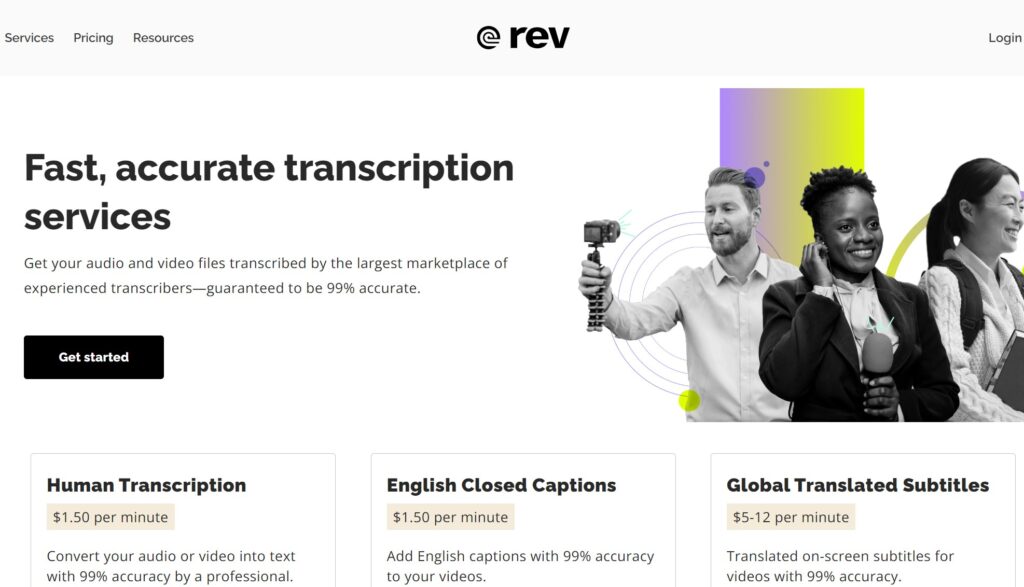
💻Key Features:
- Audio Transcription.
- Video Captioning makes video content accessible to a broader audience.
- Rev.com can add subtitles to videos in multiple languages.
- Translation Services.
- Audio Recording Services.
- Transcription Editing Tools.
- Rev.com can provide verbatim transcriptions, including filler words and non-verbal expressions.
👍Pros:
- Rev.com provides accurate transcription and captioning services.
- It offers a variety of services, including audio transcription, video captioning, and document translation.
- Users can choose from different turnaround times, including expedited options, to meet tight deadlines.
- Rev.com accepts various audio and video file formats.
👎Cons:
- Human transcriptionists may make occasional errors.
- The platform may not support as many languages for translation as dedicated translation services.
💰Pricing:
Rev offers automated transcription services at a rate of $0.25 per minute and manual transcription services at a rate of $1.25 per minute.
Quillbot
QuillBot AI tool serves as a valuable resource for journalists, aiding them in rewording and rephrasing sentences. It simplifies the task of preventing plagiarism and enhancing the overall coherence of their writing.
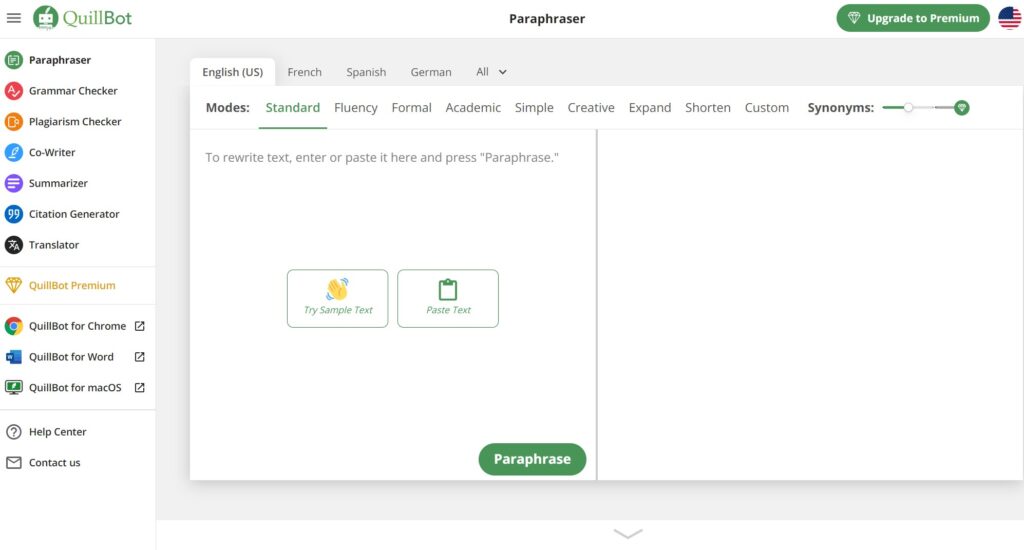
💻Key Features:
- Paraphrasing and Rewriting.
- Grammar and Style Checking.
- Sentence Combining.
- Tone Adjustment helps them make content more formal, casual, or professional based on their needs.
- Citation and Reference formatting according to various style guides, such as APA or MLA.
- Translation.
- Text Summarization.
- Plagiarism Detection
👍Pros:
- QuillBot offers synonym suggestions.
- Users can collaborate with others in real time.
- QuillBot can generate extended text based on user input.
- The platform can reorder paragraphs to improve the logical flow of a document or essay.
- Users can fine-tune QuillBot’s suggestions and settings to match their writing style and preferences.
👎Cons:
- To unlock the full range of features, users may need to subscribe to the premium version.
- QuillBot has limitations on the size of documents that can be processed.
💰Pricing:
- Free Plan: free.
- Premium Plan: Priced at $19.95 per month, billed annually.
- Business Plan: Contact QuillBot for custom pricing tailored to business requirements.
Factmata
Last but not least is Factmata. Fact-checking is an essential part of journalism, and Factmata uses AI to help journalists verify the accuracy of information and detect misinformation.
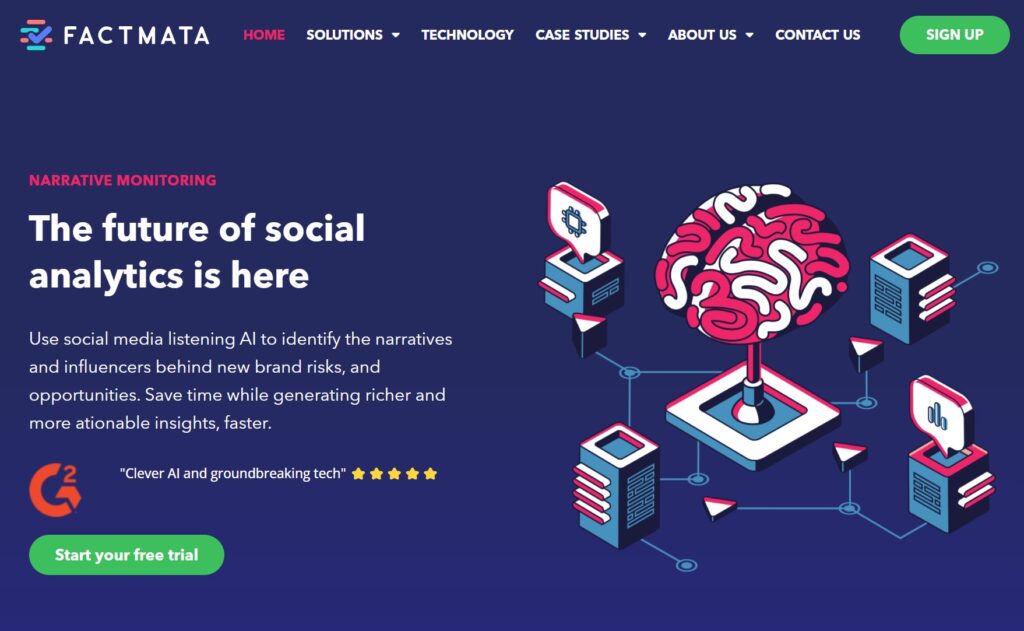
💻Key Features:
- Content Scoring is based on its quality, credibility, and potential for misinformation.
- Integration into websites, social media platforms, and content management systems.
- API Access.
- Machine Learning Insights.
- Categorization of content into various types, such as news, opinion, satire, and more.
- Audience Engagement Insights.
👍Pros:
- Factmata’s AI-driven algorithms are effective at identifying potential misinformation.
- The platform is adept at detecting hate speech, offensive language, and abusive content.
- Users have the flexibility to create custom AI models tailored to their specific content quality and safety requirements.
- Factmata’s content moderation tools are valuable for reviewing and filtering harmful or inappropriate.
- The platform offers data visualization tools that help users track trends, patterns, and the effectiveness of content moderation efforts.
👎Cons:
- Factmata’s advanced AI features may be complex for some users.
- Users need to consider data privacy and security concerns when using a third-party platform for content moderation and analysis.
💰Pricing:
- Free Plan: Threat Score for 1 topic. (Free)
- Basic Plan: Threat Score for 1 topic. $300 per month.
- Enhanced Plan: Threat Score for up to 3 topics. Price: $250 per topic per month.
- Pro Plan: Threat Score for up to 5 topics. Price: $225 per topic per month.
- Enterprise Plan: Threat Score for up to 10 topics. Price: $200 per topic per month.
>> Don’t Miss:
- 10 Best AI Tools for Sales (2024)
- 7 Best AI Tools for Lawyers (2024)
- 7 Best AI Tools for Architects (2024)
- 8 Best AI Tools for Job Seekers to Land a Job (2024)
Frequently Asked Questions about AI Tools for Journalists 🤔
Are AI tools a replacement for journalists?
AI tools are not a replacement for journalists but rather tools that enhance their capabilities. While AI can automate certain tasks, journalists are still essential for critical thinking, investigative reporting, and ethical decision-making in journalism.
Are there AI tools that can detect fake news or misinformation?
Yes, some AI tools are designed to detect fake news and misinformation. They use natural language processing and machine learning techniques to analyze the credibility and accuracy of online content.
Do AI tools have limitations in journalism?
AI tools have limitations, such as the potential for bias in algorithms, accuracy challenges in natural language understanding, and the need for human oversight and ethical considerations in content creation and decision-making.
Can AI tools be used for investigative journalism?
AI tools can assist investigative journalism by sifting through large datasets, identifying patterns, and providing leads. However, the core investigative work, like in-depth research, interviews, and verification, is primarily the domain of journalists.
How can journalists choose the right AI tools for their needs?
Journalists should consider their specific needs, the tool’s features, ease of use, and whether the tool aligns with their editorial standards and ethical considerations when choosing AI tools for their work.
>> Don’t Miss: 10 Best AI Tools for Business (2024)
Conclusion 📌
AI tools empower journalists, editors, and reporters by enhancing productivity and efficiency in research and content creation. They utilize AI, machine learning, deep learning, and natural language processing to expedite writing and fact-finding. Real-time collaboration is possible, further streamlining operations. While AI expedites research and writing, it’s essential to remember that human verification and analysis are crucial. AI tools significantly save time and resources in journalism.
>> Check more recommendations on the best AI tools.




